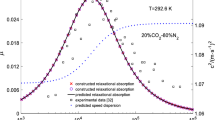Abstract
The minimum possible pressure at which a sound wave can propagate in a perfect gas has been found based on the dispersion relation. Using the molecular‐kinetic theory it has been shown that this process can occur with such a minimum density when a quarter of a wavelength fits into the distance between molecules. A certain analogy between the propagation of a sound wave under these conditions and the propagation of an electromagnetic‐energy quantum has been noted.
Similar content being viewed by others
REFERENCES
L. D. Laudau and E. M. Lifshits, in: Hydrodynamics [in Russian], Vol. 6, Moscow (1986), p. 436.
H. Schlichting, in: Boundary-Layer Theory [Russian translation], Moscow (1974), pp. 22
R. Feynman, R. B. Leighton, and M. Sands, in: The Feynman Lectures on Physics [Russian translation], Vol. 4, Moscow (1965), p. 164.
V. G. Levich, Course of Theoretical Physics [in Russian], Vol. 1, Moscow (1962).
G. N. Agramovich, Applied Gas Dynamics [in Russian], Moscow (1976).
Author information
Authors and Affiliations
Rights and permissions
About this article
Cite this article
Volobuev, A.N., Tolstonogov, A.P. Distinctive Features of the Propagation of Sound Waves in a Perfect Gas at Low Pressure. Journal of Engineering Physics and Thermophysics 76, 163–167 (2003). https://doi.org/10.1023/A:1022944031027
Issue Date:
DOI: https://doi.org/10.1023/A:1022944031027




